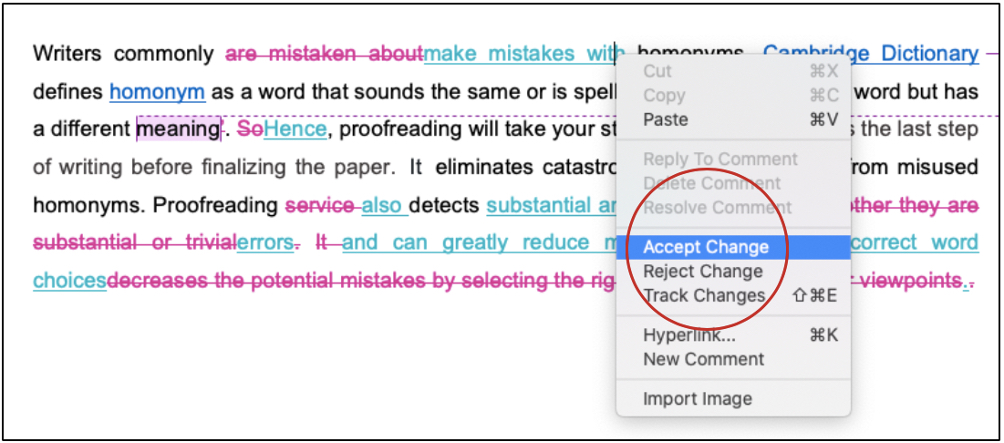Most researchers do not fully comprehend the main difference between line editing and copyediting. Although there are some similarities between these two services (e.g., both take full note of the use of a manuscript’s language and involve improvements of the content, overall structure, and quality of the manuscript), there are still important differences between them.

Most researchers and students do not fully comprehend the main difference between line editing and copyediting services. Although there are some similarities between these two services (e.g., both take full note of the use of a manuscript’s language and involve improvements of the content, overall structure, and quality of the manuscript), there are still some important differences between these services. Both line editing and copyediting have entirely different processes and require a different set of skills during the writing process.
Line editing mainly focuses on writing style, creative content, and language use at the sentence and paragraph levels. That is, it focuses on the language used by the author to establish communication between the storyteller and the reader instead of combing through the paper for errors.
Line editing checks the following points:
Is the language of the manuscript clear, smooth, and readable to the readers?
Is the meaning of the words correct?
Working with a line editor would improve the quality of a manuscript and give the author the creative instruments to become a better writer for potential employment. Copyediting focuses on errors from a technical standpoint to ensure the manuscript follows the business standards. This type of work is also considered high-level proofreading or editing.
In this sense, copyediting aims to correct all errors in grammar, typography, punctuation, syntax, and spelling in a manuscript. It ensures consistency in spelling, hyphenation, numerals, fonts, and capitalization, tracking macro issues, such as internal consistency. A manuscript should have internal consistency in terms of meaning. The setting, plot, or characters of the study should have no discrepancies throughout the paper.
For instance, suppose that in Section 2, you write: the participants of the study from a rural area in South Africa, and then write in Section 4: the participants of the study from the urban area in South Africa, it is the copy editor’s job to correct this if both renditions are meant to refer to one and the same thing.
Of course, there will be some convergence between editing and copyediting. As mentioned earlier, the main purpose of editing is to address technical errors or logical inconsistencies because the main role of an editor is to polish up a manuscript. However, it is not the specific aim of line editing to screen the manuscript, correct the errors in grammar, punctuation, syntax, and spelling, or change behaviour to behavior just because the targeted journal is in the United States. This is a copyediting task and requires technical comprehension skills of English usage (either British variant or American variant) that general editing does not possess. In this sense, copyediting involves checking the citation style—a set of rules on how to properly cite a source in an academic manuscript. Hence, editing services may not offer to check the APA style or Harvard style, but copyediting might.

The other main difference between copyediting and line editing is that copyediting should always be done after line editing, never at the same time. Thus, copyediting is considered the last task before the manuscript goes into publication. A regular editor or line editor should check errors in grammar, punctuation, syntax, and spelling in a manuscript before copyediting.
As a consequence, the main role of copyediting or line editing services is to make your paper stand out and help you to produce writing of increasingly better quality and, therefore, correct all grammatical, spelling, or punctuation flaws to make sure the document is error-free.
Authors should keep in mind that companies providing editing, proofreading, copyediting, or line editing services cannot ever guarantee a client’s manuscript will be accepted for publication because peer-review journals do not only look at these types of errors but also at the scientific or literary quality of the content—a matter for which a copy editor or a line editor cannot be held responsible.
The purpose of proofreading is to correct all errors in grammar, punctuation, syntax, and spelling in a manuscript. When authors wish to see whether the final version of their manuscript includes any minor errors, what they need is a proofreading service, not an editing service. However, editing services require more effort from an editor than do proofreading services. An editing service aims to improve the academic quality of the paper. Thus, editing comprises improvements of the content and overall structure of the manuscript.
Editing services make essential revisions to improve the standard of the academic writing of a document. In this sense, an editor sometimes re-writes some parts of the paper. This is important because the purpose of editing is to ensure that the manuscript’s purpose is met.
Editing also covers checking documents to see whether they have any grammatical, spelling, or punctuation errors to ensure the paper is error-free. Thus, an editor will correct all errors in grammar, typography, punctuation, syntax, and spelling in a manuscript. In this sense, editing services cover proofreading services as well (click here to read about the difference between editing and proofreading).
What is Proofreading? Difference Between Proofreading and Editing
8 Things to Consider Before Hiring Online Editing or Proofreading Services

If you need professional help for editing, proofreading, line editing, or copyediting, please visit our service page. Best Edit & Proof expert editors aim to provide your manuscripts with proper scholarly and academic tone and style. They will significantly improve the chances of having your research manuscript accepted for publishing. They provide subject-area proofreading and editing services in several fields categorized under various disciplines. With our extensive knowledge and expertise, we will help you find the right tone and style for your manuscript.
If you need our subject-area editors to format your manuscripts, giving you the fundamental rules for formatting your manuscripts as described in your guidelines, such as APA, MLA, or Chicago/Turabian styles, then contact us. At Best Edit & Proof, our proofreaders and editors edit every type of academic paper. We have a user-friendly website and a simplified ordering process.
You can also avail of our assistance if you are looking for editors who can format your manuscript, or just check on the particular styles for the formatting task as per the guidelines provided to you, e.g., APA, MLA, or Chicago/Turabian styles. Best Edit & Proof editors and proofreaders provide all sorts of academic writing help, including editing and proofreading services, using our user-friendly website, and a streamlined ordering process.
Visit our order page if you want our subject-area editors or language experts to work on your manuscript to improve its tone and style and give it a perfect academic tone and style through proper editing and proofreading. The process of submitting a paper is very easy and quick. Click here to find out how it works.
Our pricing is based on the type of service you avail of here, be it editing or proofreading. We charge on the basis of the word count of your manuscript that you submit for editing and proofreading and the turnaround time it takes to get it done. If you want to get an instant price quote for your project, copy and paste your document or enter your word count into our pricing calculator.
Contact us to get support with academic editing and proofreading. We have a 24/7 active live chat mode to offer you direct support along with qualified editors to refine and furbish your manuscript.

Follow us on Twitter, LinkedIn, Facebook, Instagram, and Medium.
For more posts, click here.
This article discusses the difference between copy-editing and line editing. To give you an opportunity to practice proofreading, we have left a few spelling, punctuation, or grammatical errors in the text. See if you can spot them! If you spot the errors correctly, you will be entitled to a 10% discount.
How Much Do Professional Editing and Proofreading Cost?
01.02.2022
How Much Do Proofreading and Editing Cost?
19.06.2021
How to Choose a Dissertation Editor in 3 Steps
23.05.2022
8 Proofreading Tips: Everything to Understand the Process
30.04.2022
Dissertation Proofreading: Four Easy-to-Follow Steps
28.04.2022

Every book that you read, every newspaper and magazine you subscribed to, every blog that you have come across — all went through the radar of editing and proofreading before coming to you. So, if you are thinking about whether you can make a career in the field of editing and proofreading or not, the answer is yes. The only thing is, you need to have the talents and the qualifications, all of which we will discuss in this article. Therefore, if you are ready, let us look at all the things you need to know to become a proficient editor or proofreader.
Continue Reading
Academic writing requires precision and accuracy, with special attention to formats and writing style. Therefore, being careless in this case is not an option. But even though it is such a meticulous form of writing, enough practice and the right advice can help you skillfully master it. Proofreading (and editing) is one such means to achieve perfection in academic writing. If you ever wonder whether proofreading and editing are required for academic writing, the answer is yes. Without them, you will not be able to reach the full potential of your work. Therefore, if you are thinking of getting started with it for your academic writing, here is a good place to begin.
Continue Reading
While writing a piece on any subject, generally, we focus on the facts that make up the actual content. While we focus on writing the right words, we may neglect some grammatical mistakes and other writing mistakes. This is where editing and proofreading come into the picture.
Continue Reading
If you are a bilingual student having English as your second language, you would not doubt the necessity of proofreading or editing anything you write. Its importance goes one notch higher, when you are working on your academic thesis or dissertation. Are you looking for someone who can help you in editing a thesis or dissertation for you? Before you delve further to find out the right expert to edit or proofread your dissertation/thesis, read this article to know the nitty-gritty of thesis proofreading and editing.
Continue Reading
Proofreading a dissertation differs from dissertation editing in the aspect that it does not drastically change the composition of the manuscript. The fundamental purpose of dissertation proofreading is to enhance a document's linguistic clarity and formatting. And as such, the amount of time required to proofread is lower than that needed to edit a dissertation. It is an integral part of the dissertation submission process that ensures a manuscript's overall veracity. But, owing to its low turnaround time and seemingly lackluster objective, many academics do not prioritize proofreading adequately.
Continue Reading
In Academic writing, proofreading and editing services play a crucial role. However, people regularly get befuddled about the cost while seeking assistance from a proofreading and editing company. Being concerned about the situation, Best Edit & Proof has made a simple price guide to give you a basic idea about the cost of proofreading and editing services.
Continue Reading
Proofreading and editing services play a crucial role in academic writing. You can, of course, self-edit and proofread, but it is always a better alternative to rely on professional services. In this case, consulting a professional proofreading and editing service to make your academic work flawless and more attractive is a smart decision. However, one of the main concerns people have while going for these services is that they are not aware of how much they will cost or what the pricing strategy is. In this article, we will offer you a detailed guide of how much professional editing and proofreading services cost and the main pricing strategies.
Continue Reading